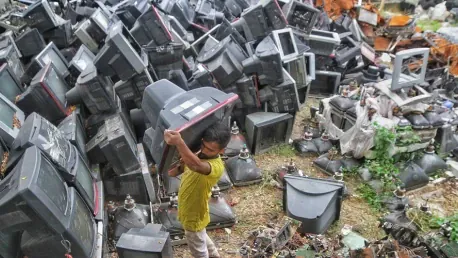Even though the pandemic is now behind us by a good few years, 2024 still marks the last year of its effects on the economic downturn. And as we are still dealing with the aftermath of this crisis, it’s important not to lose climate change out of sight. There is no excuse for not taking strong action on how we treat our planet, especially when it comes to the rubbish we create.
The mountains of trash we have piled up in the last hundred years could have bigger consequences for our society than the pandemic. While there are aspects of climate change we could focus on, in this article, we will deal with the topic of electronic waste.
At 59 Million Tons, Our E-Waste Problem Is Getting Out of Control
Back in 1991, the Macintosh PowerBook 100 was one of the first laptops. It weighed more than five pounds. In 2024, the lightest laptop weighs less than two pounds, and the lightest phone you can buy is just over three ounces—less than a standard deck of playing cards.
So why, despite all these technological improvements, we’re producing more electronic trash, than ever before? Simply because we throw away old devices more quickly as new, lighter, and slimmer models come out.
Last year, people produced 59 million US tons of e-waste, which is a record high and a 21 percent increase from just five years ago.
Experts predict that the amount of e-waste will go up by 32% to 82 million tonnes by 2030. This trend shows that valuable materials worth billions of dollars are being thrown away. Shockingly, currently, only 1% of the demand for rare earth elements is met through recycling.
In the same year, the Waste and Electrical Equipment Forum said that 5.3 billion cell phones would be thrown away. At this point, smartphones are not only impacting our mental health but our planet and our overall quality of life. The trouble is, this number has probably gone up since then. Some big phone producers, like Samsung and Apple, are trying to combat this by offering software updates for up to seven years. This means that instead of throwing away phones, they can be fixed and used for something else, which helps the environment.
Corporate Responsibility in the Staggering Surge in Global E-Waste
According to the UN Global E-waste Monitor, we produced 62 million tonnes of end-of-life electronics in 2022, an 82% increase from 2010. The amount is equivalent to discarding 1,000 laptops every second.
“Backyard recyclers” create a particularly sensitive issue with their practices in India, Indonesia, and Thailand. These workers try to extract gold from circuit boards using nitric and hydrochloric acid or even by cooking e-waste in stoves. Shockingly, many of these workers are children with no protective gear who get paid as low as three dollars a day. Some recyclers, who claim to care about the environment, send their electronics overseas to be processed. In these places, workers are paid low wages and work in dangerous conditions.
In response to this difficult situation, EU Right to Repair laws were a big step forward. They moved away from recycling as an environmental panacea and began to actively promote and incentivize reuse as an alternative. France has gone a step further and introduced a Repairability Index, giving consumers more information to help them choose repairable products.
The corporate sector creates a significant portion of this type of landfill scrap. In fact, 10% of EU businesses admitted to disposing of unused IT equipment, and 25% were uncertain where or how their old technology is discarded.
However, not all is bad—these numbers were valid before the COVID-19 pandemic. Since then, many offices have stopped using desktop computers and have bought new technology to support remote work.
A Two-Pronged Approach Toward a Sustainable Future
To tackle this climate stressor, we need a two-part plan: the government must create rules that make manufacturers and businesses responsible for their e-waste, and businesses need to change the way they use technology.
Education will be key, but business leaders know they can no longer wait for government instructions. Consumers and investors are demanding action now. The International Telecommunication Union, which was involved in the release of the Global E-waste Monitor 2020, wants 50 percent of the world’s nations to have these laws by 2023. This would increase the current number from 78 to 97.
In 2014, only 61 countries had these laws, so reaching this goal is difficult yet possible. Currently, just over half of the US states have laws about disposing of waste. However, there’s no national law requiring electronic scrap to be recycled or stopping it from being sent to developing countries, even though there have been many suggestions for these laws over the years.
To do their part, businesses, organizations, and individuals who regularly need to get rid of their old electronics can choose recyclers that have joined the e-Stewards Initiative. This program certifies recyclers based on strict standards for responsible practices. To get certified, recyclers must agree not to export any hazardous or illegal e-waste to developing nations, dispose of it in landfills, or use forced or child labor for recycling.
Economic and Environmental Benefits of the Circular Economy
It is going to take drastic action to encourage businesses to repair devices rather than replace them to help boost the economy. Tackling e-waste will require a concerted effort from both the public and private sectors.
It will be virtually impossible for companies to meet the current Government’s targets of becoming net zero by 2050 if steps aren’t taken to push business owners toward recycling and repairing rather than just replacing. With the mountain of electrical waste predicted to grow to 74 million tonnes a year by 2030, we need to:
Think about getting rid of or reducing the VAT on technology repairs.
Start a program that gives out vouchers for repairs to encourage people to get their electronic devices fixed instead of buying new ones.
Make it a rule for businesses to make sure that at least 10 percent of the technology they buy each year is refurbished or repaired.
We must raise our collective consciousness and get devices repaired instead of throwing phones away after a year or two while they are still usable. Governments need to make it easier by introducing sustainable incentives such as removing VAT from refurbished tech or adopting proven schemes like those seen in Europe to incentivize repairs.
A Call for Collective Action and Sustainable Solutions
As we navigate the final year of the post-pandemic economy, it is vital to consider the escalating issue of electronic waste. Electronic scrap will continue to pose significant environmental and economic challenges. To combat this, we must push for our governments to enforce strict regulations that prioritize repair and reuse.
Buying a refurbished device, or sending it to be recycled when it finally is beyond repair, is vital in today’s drive to respect the planet and adopt a more sustainable approach in business. It’s time to give e-waste the attention it needs when we’re looking at future polices.









